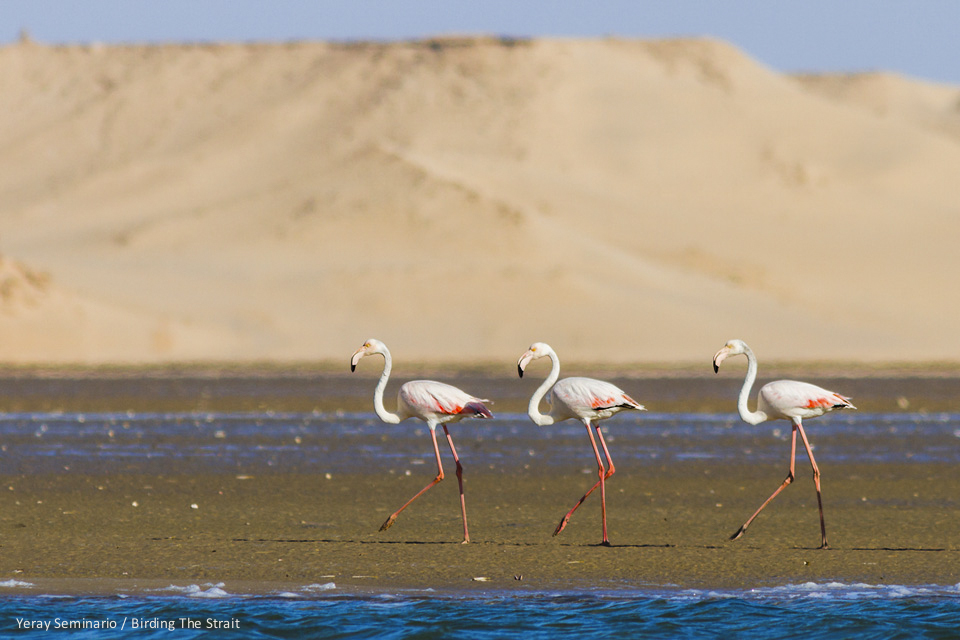
In autumn 2015 we were asked by Dakhla Attitude Hotel, to scout the area and assess the possibilities to accommodate birding and nature enthusiasts’ groups during trips to the Atlantic Sahara. We scheduled the trip for the middle of February 2016, which is a good time for birding in the area both in terms of phenology and weather.
Following the expansion of the Dakhla airport and the current sociopolitical stability in the area, the interest of Dakhla as an international touristic destination has significantly grown over the last years. Nowadays it constitutes a very popular destination for international surfers. Besides, recent pioneering birding and wildlife trips to the Bay of Dakhla and Aousserd region are increasing, resulting in regular records of new or very scarce species of birds and mammals for the Western Paleartic region, sometimes in unprecedented numbers.
Some of the most significant species include: Sudan Golden Sparrow, Golden Nightjar, Cricket Longtail, Black-crowned Sparrow-Lark, Dunn´s Lark, African Royal Tern, Kelp Gull and Namaqua Dove among birds; and Fennec, Sand Cat, Rüppell´s Fox, Ratel, Orca and Atlantic Humpbacked Dolphin among mammals.
No doubt, the discovery of highly attractive species of wildlife will keep growing in forthcoming years making of the Dakhla region a top destination for international nature enthusiasts.
We visited the area in mid February 2016 and this report summarizes our experience. All the photos illustrating the report were obtained within the framework of the described scouting trip. You can see and download the entirety of the trip report here: Dakhla Trip Report – Feb 2016.

Day 1, 13 February: Málaga – Dakhla
We flew to Dakhla from Malaga, via Casablanca, with Royal Air Maroc in an uneventful flight. We passed customary passport and hand-luggage control without any enquiries about our large optics equipment. At the airport, Bruno Muchada, Manager of the Dakhla Attitude, and its staff welcomed us and took us to the hotel and showed us our room after having welcome pastries and Moroccan tea.
This hotel is strategically located on the northern side of Dakhla Bay (35km from the airport), with splendid views to the lagoon and Herne Island (called by some as Dragon Island, because of its similarity in shape to famous dragon in Neverending Story – Fujur!). We went straight to bed in our cozy bungalow to get some rest before the beginning of our scouting trip.
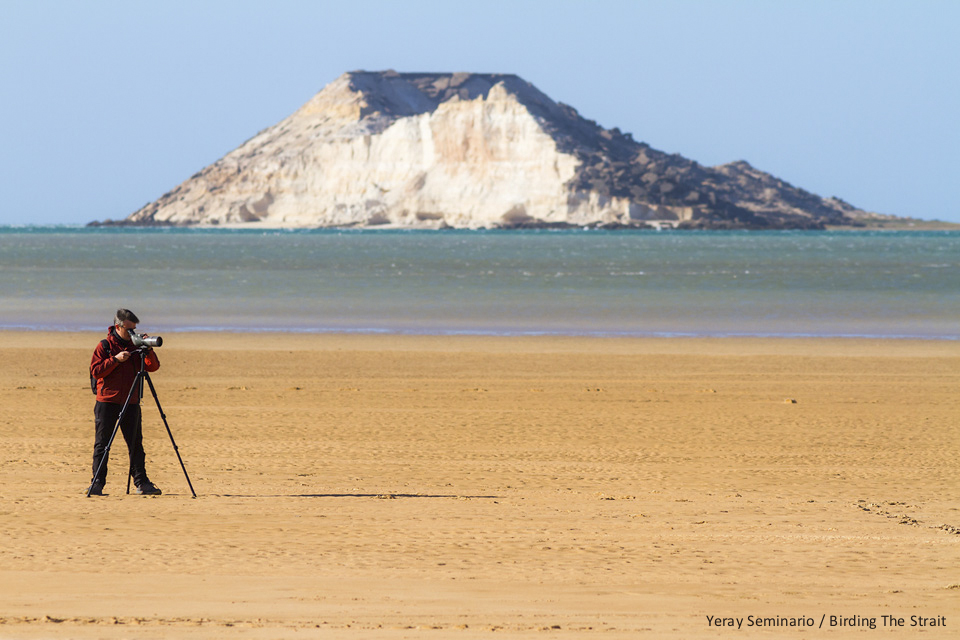
Days 2 & 3, 14 & 15 February: Dakhla Attitude, West Bay of Dakhla and La Sarga Point.
Our first day began before sunrise with the calls of House Sparrows out of our cabin. This might not be a remarkable record, except for the fact that this species has only recently colonized the Atlantic Sahara, being the first record of the region in 1988. Another common bird in the hotel grounds was the Black Wheatear, which were seen feeding chicks and showing a surprisingly inquisitive behavior.
In our early morning birding session around the hotel we got the only Mediterranean Gull of the trip, a 2nd winter individual, over 60 Greater Flamingos, groups of marocanus Great Cormorants approaching the bay, over 150 Bar-Tailed Godwits, 50 Oystercatchers, and many Grey, Kentish and Common Ringed Plovers, 30 Slender–billed and 15 Audouin’s Gulls, and 6 Royal Terns.
We realized that the irrigated vegetation in the hotel gives cover to some passerines, such as White Wagtail, Yellow Wagtail (ssp. flava), Common Chiffchaff, Eurasian Blackcap and Sardinian Warbler. We also saw several chiffchaffs in the gardens with a similar appearance to Iberian Chiffchaff, and we realized this was the case when we had one of these birds singing in front of us the full typical song.
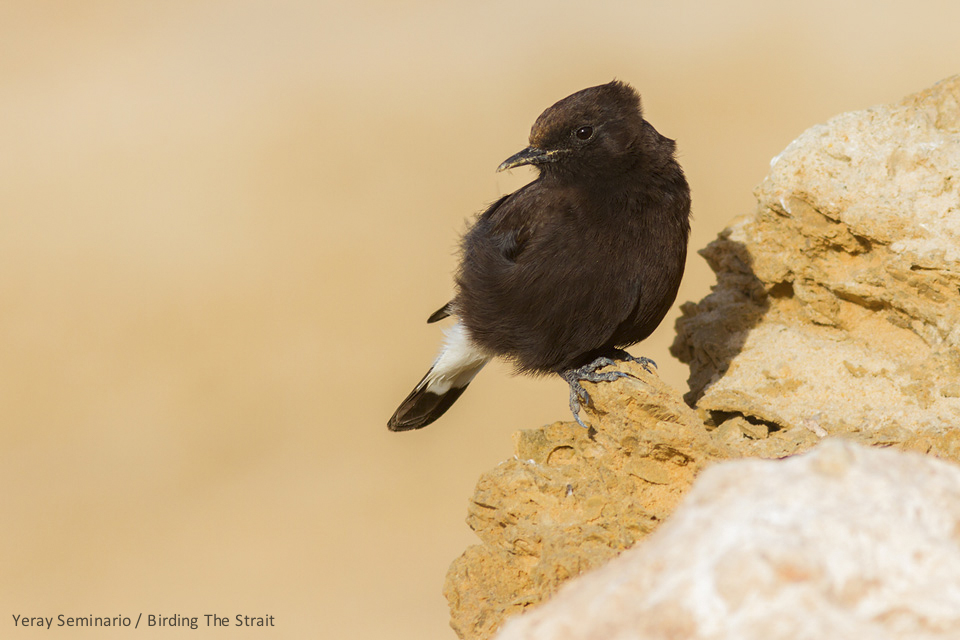
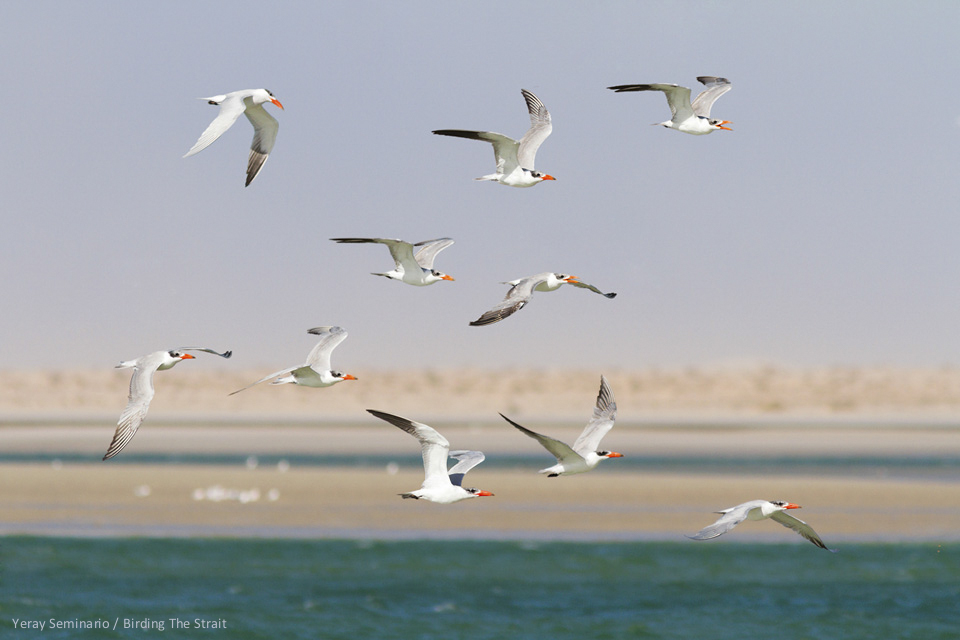
The edge of the bay is just a few feet away from the cabins. Here, we could see good numbers of Greater Flamingo, Eurasian Spoonbill and Caspian Tern, as well as plenty of waders and gulls. A very skilled fisherman was collecting the nets and discarding some of the fish that were immediately caught in the air by the terns.
We also made two visits to La Sarga, the southernmost tip of the Dakhla peninsula, and Oum El Bouir, which is a hotspot for seawatching. We saw, among others, Northern Gannet, Great Skua, Arctic Skua, Sandwich Tern, around 400 Audouin’s gulls and probably more than 2500 Lesser Black-backed Gulls in every visit. We managed to read over 50 color rings.
Caspian Tern deserves special mention due both to its large flocks (often over 100) and their proximity to the road, providing excellent opportunities for photography. At the tip of La Sarga, there are hundreds of colorful fishing boats lying on the sand, which provide shelter from the wind to flocks of Ruddy Turnstone, Kentish Plover, Dunlin and Sanderling.
Back at the hotel we had an excellent Tajine and made a toast with a “Stork”, Moroccan premium lager!

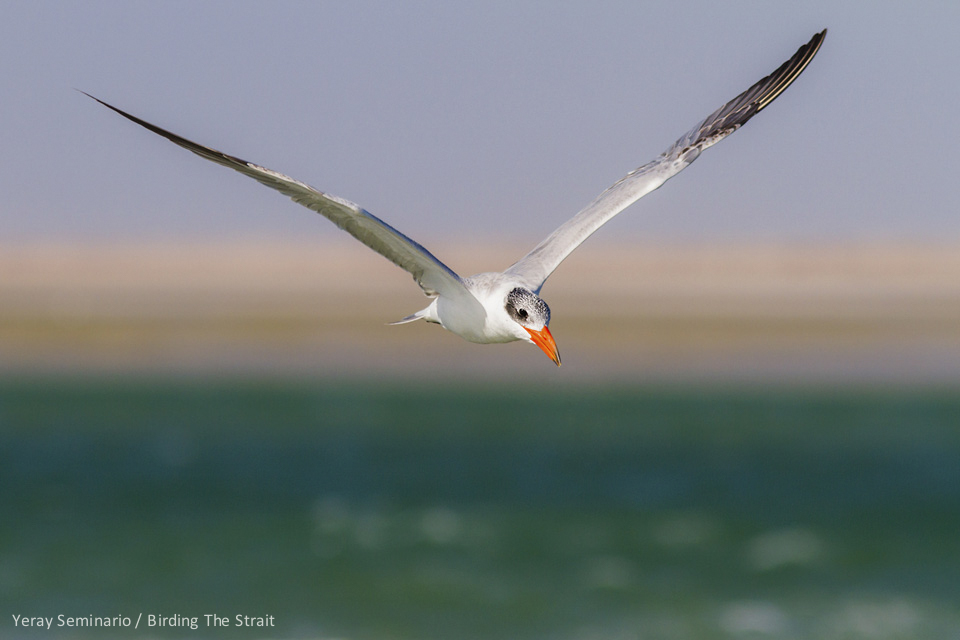
Day 4, 16 February: Sebkhet Imlily wetland
Following the recommendations from Dakhla Attitude staff, we went to explore the Sebkha Imlily wetland, 80km south from our hotel. This is a unique ecosystem consisting on a group of deep saltwater ponds, which was surveyed by scientists for the first time in 2009 and where a relict population of Guinea Tilapia had been found.
After an hour drive in a 4X4 throughout the desert we arrived to Imlily. This is indeed a true Oasis. Several ponds of crystal-clear water, filled with tilapias, lay on a wide plain surrounded by white-sand dunes, conforming an unreal and unique sight. The origin of this relict population and the hydrogeology of the wetland remain largely unknown.
Surrounding the ponds, there are reedbeds that attract migrants, dragonflies and other insects. This could be a particularly interesting place for migratory birds. Our friends from Association Nature Initiative mentioned that in previous visits they found dead raptors around the ponds. This is probably a natural ecological trap, as the waters of these ponds are highly concentrated in salt, so exhausted birds and other animals in need of water might get sick and die after drinking from the pools. In fact, it didn’t take long until we found the skeletons of three Short-toed Eagles.
It’s worth mentioning that we also found tracks and scat of Rüppell’s Fox. A night drive and hike would surely provide remarkable mammals sightings.
Exploring one of the many caves present in the vicinity of Imlily, we were delighted to find a strikingly pale Little Owl of the saharae subspecies. Indeed, this is the southernmost limit of the species range, and the local phenotypes obviously differ from those found in northern Morocco.
In our way back to Dakhla, we saw some movement in a bush by the side of the road, we stopped to check it out, and to our surprise, a Great Spotted Cuckoo, up to 4 hoopoes and 2 Northern Wheatears took off. Some of the other birds in the area were a family group of Cream-colored Courser, Kentish Plover, Southern Grey Shrike and Desert Wheatear.
All in all, we can say that Imlily is a unique, fascinating place that surely will bring more interesting sightings in the future.
Back in the Hotel, in the last hours of the day, with an excellent light, we went to the nearby northern side of the Bay of Dakhla, to contemplate the spectacle of thousands of waders feeding in the mudflats.

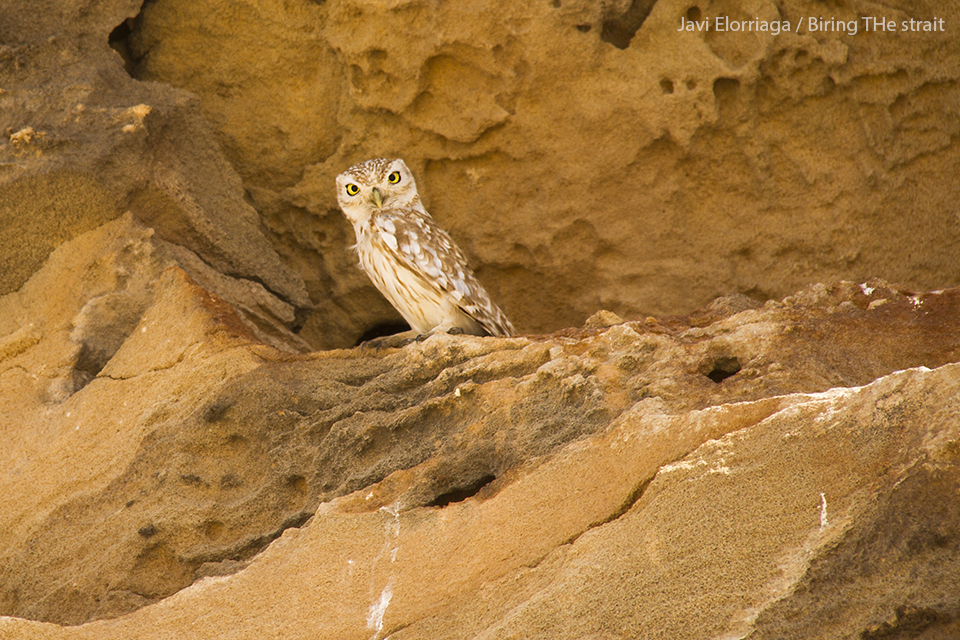
Day 5, 17 February: Pointe de l’Or beach and West Bay of Dakhla
We woke up before sunset and directly walked from our room to the shore of the bay with the very first light for a birding session before breakfast. We added Pied Avocets and a group of 11 Northern Pintails to the trip list and found good numbers of Oystercatchers, Grey and Kentish Plovers, Eurasian Curlews, Bar-tailed Godwits and Sanderlings all around. Over 50 Greater Flamingos, a further similar number of marocanus Great Cormorants and a dozen of Northern Gannets were present as well. Within a group of Slender-billed Gulls and Caspian Terns we soon came through one of our most wanted species, two magnificent adult Royal Terns.
Next we spend a couple of hours seawatching into the Atlantic from the nearby Pointe de l’Or. Here, in the absolute solitude of a never ending unspoiled beach, we scanned a large group of 150 Lesser Black-backed, 10 Yellow-legged and 150 Audouin’s Gulls and got some additional color rings. A confiding group of 120 Caspian Terns and a few Sandwich Terns were roosting on the beach and greatly inspired us for a photo session.
We found a perfect vantage point for seawatching in the top of a large flat rock. In a little time, up to 6 Atlantic Storm-Petrels flew southwards over the surf break while 3 Great Skuas and plenty of Northern Gannets passed north in the distance. Driving in a sandy trail back to the main road we saw a large raptor landing on the dunes which turned out to be a migrant Short-toed Eagle.
At lunch time we visited the Dakhla Oyster Farm. With the rising tide thousands of gulls and waders concentrated in the sand banks. Within a group of Lesser Black-backed Gulls we rapidly noticed the presence of a bulky adult individual with blackish mantle and similar size to the Great Cormorants standing by its side. Inevitably we thought it might well be an adult Kelp Gull, as the species has been repeatedly reported in the area in recent years. However, the distance and strong sunlight did not allow definite views. Moreover, we still had in our mind the adult Great Black-backed Gulls we had seen the previous winter at Khnifiss Lagoon and, therefore, did not feel in a position to reliably discern between both species. We had a nice time observing up to 12 Royal Terns and the cooperative feeding of Little Egrets and Spoonbills. Meanwhile, two Ospreys flew overhead contact-calling “pyep!”.
On our way back to the hotel, we spotted three Laughing Doves in courtship display and a group of Little Swifts.
—
In the next post we will narrate our expedition to Aousserd, including visits to the mythic Oued Jenna and Leglat Derraman.